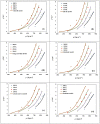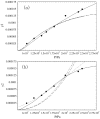Simulation and Optimization: A New Direction in Supercritical Technology Based Nanomedicine
- PMID: 38135995
- PMCID: PMC10741229
- DOI: 10.3390/bioengineering10121404
Simulation and Optimization: A New Direction in Supercritical Technology Based Nanomedicine
Abstract
In recent years, nanomedicines prepared using supercritical technology have garnered widespread research attention due to their inherent attributes, including structural stability, high bioavailability, and commendable safety profiles. The preparation of these nanomedicines relies upon drug solubility and mixing efficiency within supercritical fluids (SCFs). Solubility is closely intertwined with operational parameters such as temperature and pressure while mixing efficiency is influenced not only by operational conditions but also by the shape and dimensions of the nozzle. Due to the special conditions of supercriticality, these parameters are difficult to measure directly, thus presenting significant challenges for the preparation and optimization of nanomedicines. Mathematical models can, to a certain extent, prognosticate solubility, while simulation models can visualize mixing efficiency during experimental procedures, offering novel avenues for advancing supercritical nanomedicines. Consequently, within the framework of this endeavor, we embark on an extensive review encompassing the application of mathematical models, artificial intelligence (AI) methodologies, and computational fluid dynamics (CFD) techniques within the medical domain of supercritical technology. We undertake the synthesis and discourse of methodologies for calculating drug solubility in SCFs, as well as the influence of operational conditions and experimental apparatus upon the outcomes of nanomedicine preparation using supercritical technology. Through this comprehensive review, we elucidate the implementation procedures and commonly employed models of diverse methodologies, juxtaposing the merits and demerits of these models. Furthermore, we assert the dependability of employing models to compute drug solubility in SCFs and simulate the experimental processes, with the capability to serve as valuable tools for aiding and optimizing experiments, as well as providing guidance in the selection of appropriate operational conditions. This, in turn, fosters innovative avenues for the development of supercritical pharmaceuticals.
Keywords: computational fluid dynamics; machine learning; model; particles; supercritical fluids.
Conflict of interest statement
The authors declare no conflict of interest.
Figures












Similar articles
-
Recent advancements toward the incremsent of drug solubility using environmentally-friendly supercritical CO2: a machine learning perspective.Front Med (Lausanne). 2024 Sep 2;11:1467289. doi: 10.3389/fmed.2024.1467289. eCollection 2024. Front Med (Lausanne). 2024. PMID: 39286644 Free PMC article. Review.
-
Computational intelligence modeling and optimization of small molecule API solubility in supercritical solvent for production of drug nanoparticles.Sci Rep. 2025 Apr 28;15(1):14774. doi: 10.1038/s41598-025-99776-1. Sci Rep. 2025. PMID: 40295721 Free PMC article.
-
Supercritical fluid technology for solubilization of poorly water soluble drugs via micro- and naonosized particle generation.ADMET DMPK. 2020 Jun 29;8(4):355-374. doi: 10.5599/admet.811. eCollection 2020. ADMET DMPK. 2020. PMID: 35300190 Free PMC article. Review.
-
Intelligence computational analysis of letrozole solubility in supercritical solvent via machine learning models.Sci Rep. 2024 Sep 17;14(1):21677. doi: 10.1038/s41598-024-73029-z. Sci Rep. 2024. PMID: 39289569 Free PMC article.
-
Nanoparticles in the pharmaceutical industry and the use of supercritical fluid technologies for nanoparticle production.Curr Drug Deliv. 2012 May;9(3):269-84. doi: 10.2174/156720112800389052. Curr Drug Deliv. 2012. PMID: 22283656 Review.
References
-
- Qin M., Xia H., Xu W., Chen B., Wang Y. The spatiotemporal journey of nanomedicines in solid tumors on their therapeutic efficacy. [(accessed on 20 November 2023)];Adv. Drug Deliv. Rev. 2023 203:115137. doi: 10.1016/j.addr.2023.115137. Available online: https://api.semanticscholar.org/CorpusID:265120338. - DOI - PubMed
Publication types
Grants and funding
- 2023YFB3810000, 2018YFA0107301/Major State Basic Research Development Program of China
- U22A20333, 81925019, U1705281, and 82202330/National Natural Science Foundation of China
- 20720190088 and 20720200019/Fundamental Research Funds for the Central Universities
- 2020Y4003/Science Foundation of Fujian Province
- NCET-13-0502/Program for New Century Excellent Talents in University, China
LinkOut - more resources
Full Text Sources
Miscellaneous

